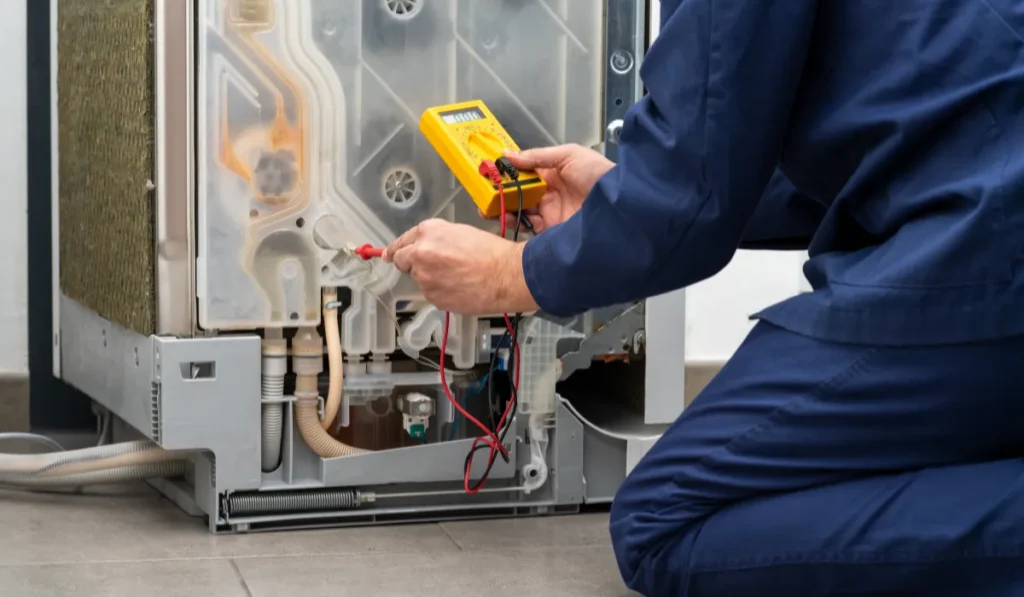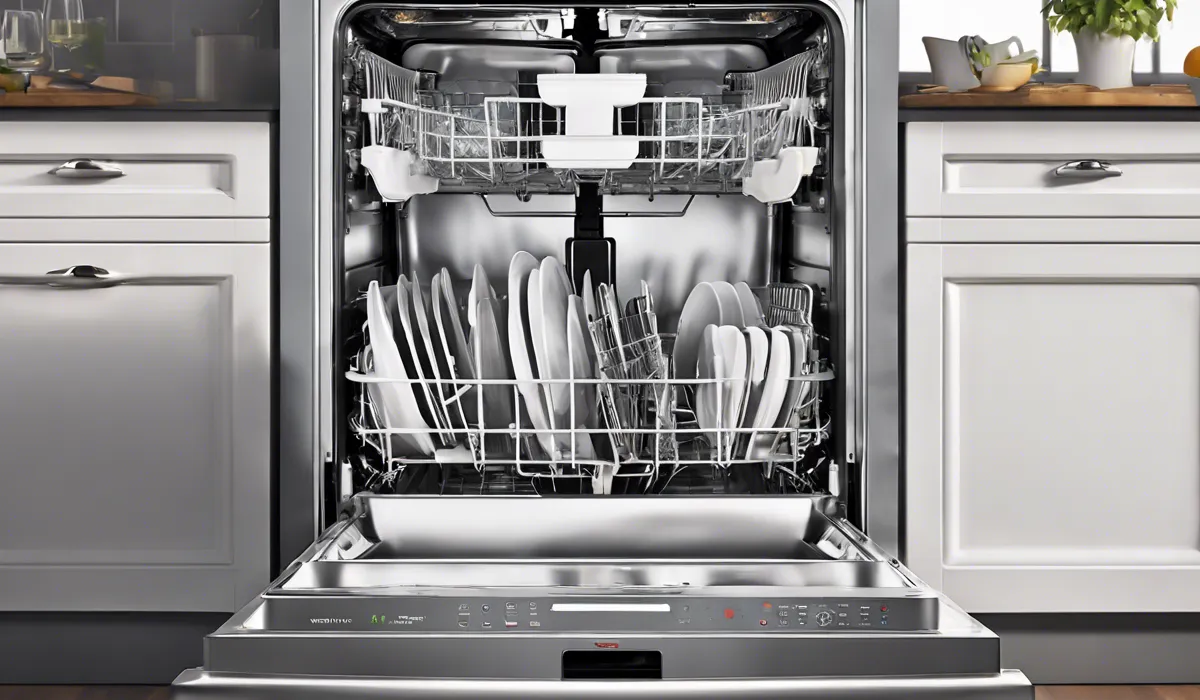How Dishwasher Works Inside Animation: A Deep Clean Dive
An animation showing the inside of a dishwasher reveals its working process: Water is heated and sprayed through rotating arms to clean dishes. Detergent is dispensed to break down food particles. The cycle ends with a rinse and hot air drying.
The Mechanics of a Dishwasher: Understanding the Core Components

Water Inlet Valve: The Gateway for Water
Imagine the water inlet valve as the starting line for a race. This valve is where the journey begins for water as it enters the dishwasher.
Acting as a gatekeeper, the valve opens at the start of the wash cycle to let in the right amount of water.
It’s crucial for the valve to work correctly because the amount of water it lets in is just enough for the dishwasher to operate efficiently without wasting any drops.
Heating Element: The Warm Heart of the Dishwasher
The heating element does more than just warm things up. It’s like the sun for the dishwasher, providing heat to make the water hot enough to dissolve detergent and clean dishes effectively.
During the drying phase, it turns up the heat to dry off the dishes, so they come out ready to use. Just like the sun’s rays dry off a wet pavement, the heating element evaporates the moisture from your dishes.
Pump and Spray Arms: The Dynamic Duo
Consider the pump and spray arms as your dishwasher’s heart and hands. Together, they work to circulate water mixed with detergent, reaching every corner and every dish.
The pump sends water to the spray arms, which then spin and spray the water with force, ensuring that every dish gets a thorough bath.
Filters: The Silent Protectors
Filters might be out of sight, but their job is vital. They catch food particles and prevent them from redepositing on clean dishes.
Think of them as goalkeepers, stopping food from getting back into the playfield, ensuring that only clean water circulates through the spray arms.
Detergent Dispenser: The Timed Perfectionist
The detergent dispenser knows all about perfect timing. It holds the detergent until the moment is just right, and then, like a magician revealing a trick, it releases the detergent to join the water and start the cleaning spectacle.
Dish Racks: The Strategic Organizers
Dish racks in a dishwasher are like shelves in a library. They keep everything organized so that each dish, glass, and utensil has its place, ensuring they are exposed to the water and detergent evenly.
Proper placement on these racks is key to getting all your items sparkling clean.
The Dishwashing Cycle: A Step-by-Step Animation

The Filling Phase: Setting the Stage
This phase is like filling up a pool before a big swim. Water flows in through the water inlet valve, filling the bottom of the dishwasher. It’s the quiet before the storm of cleaning that’s about to happen.
The Washing Phase: The Main Event
Now comes the action! The pump sends water to the spray arms, which spring into action. As the arms rotate, they spray the water and detergent mixture onto the dishes.
This is the phase where the real cleaning happens, as the water jets work hard to remove all the dirt and grime.
The Rinsing Phase: The Cleanup
After the dishes have been scrubbed clean, it’s time for a rinse. Fresh water cascades over the dishes, washing away any remaining detergent and loosened food particles. It’s like a gentle rain that washes everything clean.
The Drying Phase: The Finishing Touch
Finally, the heating element takes center stage again, warming the air inside to dry the dishes. The moist air is then released, leaving behind dry dishes. It’s the grand finale of the dishwashing cycle, ensuring that every piece comes out ready for the cupboard.
Advanced Features and Technologies in Modern Dishwashers

Soil Sensors: The Intelligent Adjusters
Soil sensors in a dishwasher are like detectives. They scan and assess how dirty the dishes are. Based on what they find, they adjust the wash cycle’s duration and intensity, making sure that energy is not wasted on dishes that only need a light wash.
Energy Efficiency Techniques: The Conservationists
Modern dishwashers come with a bag of tricks to save on water and electricity. They’re designed to do more with less, using just the right amount of resources to get your dishes clean while keeping your bills low and protecting the environment.
Noise Reduction: The Silent Operators
Thanks to sound-dampening technologies, the latest dishwashers are so quiet you might forget they’re running. With layers of insulation and quieter motors, they let you enjoy a peaceful home even when the dishwasher is hard at work.
Smart Technology: The Connected Companions
Imagine controlling your dishwasher from anywhere with just your smartphone. Smart technology makes this possible, allowing dishwashers to connect to home networks for remote operation and monitoring, so you’re always in the know and in control.
FAQs About How Dishwashers Work
How does a dishwasher clean dishes?
Dishes are cleaned in a dishwasher by heating water and spraying it through rotating arms to ensure thorough coverage and cleaning.
What role does detergent play in a dishwasher?
Detergent is dispensed during the washing cycle to help break down and remove food particles from the dishes.
How are dishes dried inside a dishwasher?
After the rinse cycle, dishes are dried using hot air that circulates within the dishwasher, evaporating remaining moisture.
What happens during the rinse cycle of a dishwasher?
The rinse cycle involves spraying the dishes with clean water to remove any remaining detergent and food particles.
How do the rotating arms in a dishwasher function?
The rotating arms in a dishwasher distribute water evenly over the dishes, ensuring that all surfaces are reached and cleaned effectively.
Final Thoughts
The animation of a dishwasher’s interior showcases its functionality. Heated water is propelled by rotating arms to cleanse the dishes, while detergent is released to dissolve food remnants.
This process culminates with a final rinse and the emission of hot air for drying, ensuring dishes emerge spotless and ready for use.





